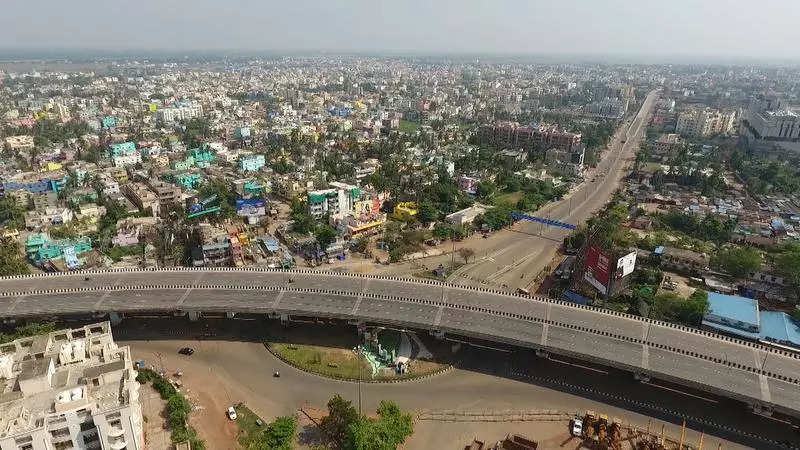As it turns 77, capital city tries to balance heritage and modernity | Bhubaneswar News

Bhubaneswar: The state capital, also known as temple city for its centuries-old shrines, is scripting a different story of a rapidly expanding metropolis with infrastructural upgrades, digital dreams and urban ambitions.
As Bhubaneswar celebrates its 77th foundation day on Sunday, it is emerging as a unique symbol of how heritage and high-tech can coexist, though not without growing pains. With significant advancements lined up, there are pressing challenges to pursue a sustainable development model, said prominent citizens and experts.
Conceived as one of India’s first planned cities, Bhubaneswar was envisioned as a clean and green administrative capital in 1948. However, long before that, in 6th century BC, it was a thriving urban centre and later the hub of Kalinga architecture, home to over 700 temples, including the iconic Lingaraj, Mukteswar and Rajarani temples. Currently, the city has expanded leaps and bounds in all directions and is fast emerging as an engine of urban growth. The city’s skyline is now dotted with skyscrapers, flyovers, IT towers, advanced healthcare, educational institutes and startup ecosystems.
“When the city was initially set up post-1948, I was a child. It comprised of nine square-sized units with a railway line passing through it and a few villages on its outskirts. The city was full of greenery with very pleasant weather throughout the year. But unplanned growth over the years has brought pressing challenges. Without following the model of other metros, Bhubaneswar must have its unique growth plan, balancing infrastructural growth and environmental sustainability,” said Lalit Mohan Patnaik, a former engineer.
Bhubaneswar’s growth has not been without hiccups, as it faced several natural disasters and challenges of unplanned expansion. Besides, the city has been facing issues like urban flooding, unregulated urban sprawl, rising population, and migration causing stress on resources. “The city has become a tech hub, but basic infrastructure has not kept pace. Traffic, waterlogging and waste management are becoming unmanageable. We need a smarter approach to growth, not a chaotic city,” said Ranjit Mohanty, an IT professional and a resident of Chandrasekharpur.
Over the years, Bhubaneswar has emerged as one of the fastest-growing cities in India, gaining momentum with the IT revolution, establishment of tech parks, a booming real estate sector, a prospering startup ecosystem, and infrastructural boost. Now, Bhubaneswar is not just a political capital but also a cultural melting pot, attracting tourists and hosting national and international sports events and investment summits.
“There are plans to develop Bhubaneswar as the no. 1 city in eastern India in the coming days,” said Bhubaneswar MP Aparajita Sarangi.
As Bhubaneswar celebrates its 77th foundation day on Sunday, it is emerging as a unique symbol of how heritage and high-tech can coexist, though not without growing pains. With significant advancements lined up, there are pressing challenges to pursue a sustainable development model, said prominent citizens and experts.
Conceived as one of India’s first planned cities, Bhubaneswar was envisioned as a clean and green administrative capital in 1948. However, long before that, in 6th century BC, it was a thriving urban centre and later the hub of Kalinga architecture, home to over 700 temples, including the iconic Lingaraj, Mukteswar and Rajarani temples. Currently, the city has expanded leaps and bounds in all directions and is fast emerging as an engine of urban growth. The city’s skyline is now dotted with skyscrapers, flyovers, IT towers, advanced healthcare, educational institutes and startup ecosystems.
“When the city was initially set up post-1948, I was a child. It comprised of nine square-sized units with a railway line passing through it and a few villages on its outskirts. The city was full of greenery with very pleasant weather throughout the year. But unplanned growth over the years has brought pressing challenges. Without following the model of other metros, Bhubaneswar must have its unique growth plan, balancing infrastructural growth and environmental sustainability,” said Lalit Mohan Patnaik, a former engineer.
Bhubaneswar’s growth has not been without hiccups, as it faced several natural disasters and challenges of unplanned expansion. Besides, the city has been facing issues like urban flooding, unregulated urban sprawl, rising population, and migration causing stress on resources. “The city has become a tech hub, but basic infrastructure has not kept pace. Traffic, waterlogging and waste management are becoming unmanageable. We need a smarter approach to growth, not a chaotic city,” said Ranjit Mohanty, an IT professional and a resident of Chandrasekharpur.
Over the years, Bhubaneswar has emerged as one of the fastest-growing cities in India, gaining momentum with the IT revolution, establishment of tech parks, a booming real estate sector, a prospering startup ecosystem, and infrastructural boost. Now, Bhubaneswar is not just a political capital but also a cultural melting pot, attracting tourists and hosting national and international sports events and investment summits.
“There are plans to develop Bhubaneswar as the no. 1 city in eastern India in the coming days,” said Bhubaneswar MP Aparajita Sarangi.
















